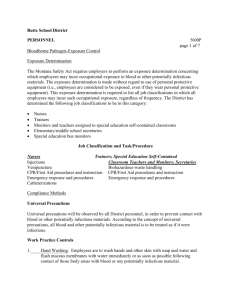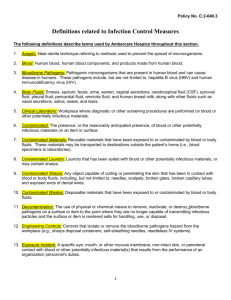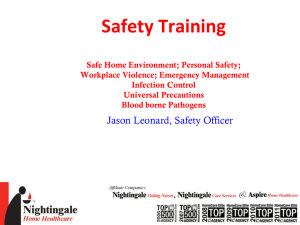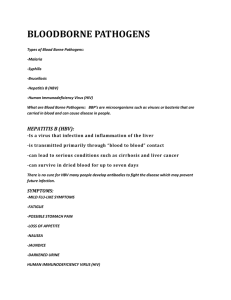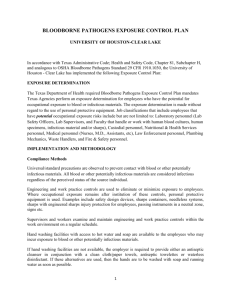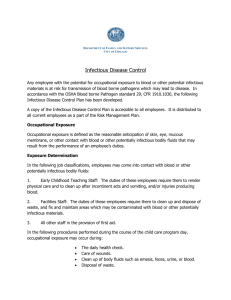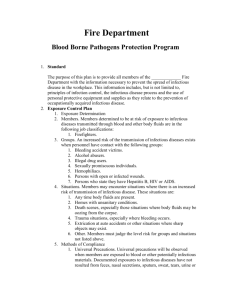Health & Safety Inform
advertisement
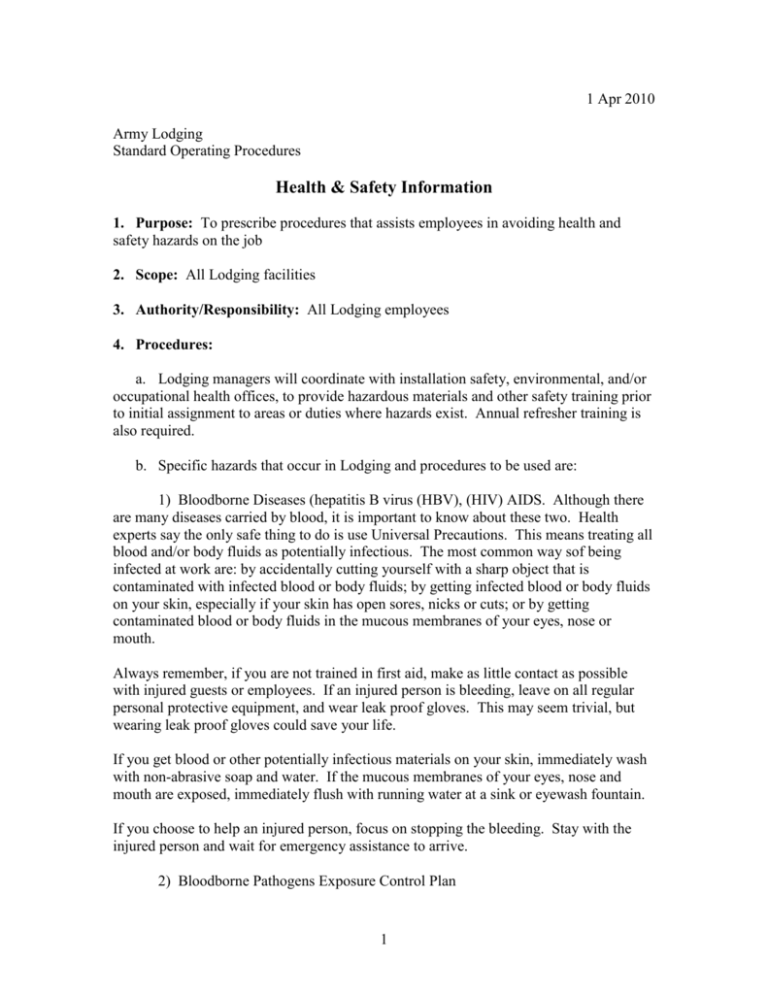
1 Apr 2010 Army Lodging Standard Operating Procedures Health & Safety Information 1. Purpose: To prescribe procedures that assists employees in avoiding health and safety hazards on the job 2. Scope: All Lodging facilities 3. Authority/Responsibility: All Lodging employees 4. Procedures: a. Lodging managers will coordinate with installation safety, environmental, and/or occupational health offices, to provide hazardous materials and other safety training prior to initial assignment to areas or duties where hazards exist. Annual refresher training is also required. b. Specific hazards that occur in Lodging and procedures to be used are: 1) Bloodborne Diseases (hepatitis B virus (HBV), (HIV) AIDS. Although there are many diseases carried by blood, it is important to know about these two. Health experts say the only safe thing to do is use Universal Precautions. This means treating all blood and/or body fluids as potentially infectious. The most common way sof being infected at work are: by accidentally cutting yourself with a sharp object that is contaminated with infected blood or body fluids; by getting infected blood or body fluids on your skin, especially if your skin has open sores, nicks or cuts; or by getting contaminated blood or body fluids in the mucous membranes of your eyes, nose or mouth. Always remember, if you are not trained in first aid, make as little contact as possible with injured guests or employees. If an injured person is bleeding, leave on all regular personal protective equipment, and wear leak proof gloves. This may seem trivial, but wearing leak proof gloves could save your life. If you get blood or other potentially infectious materials on your skin, immediately wash with non-abrasive soap and water. If the mucous membranes of your eyes, nose and mouth are exposed, immediately flush with running water at a sink or eyewash fountain. If you choose to help an injured person, focus on stopping the bleeding. Stay with the injured person and wait for emergency assistance to arrive. 2) Bloodborne Pathogens Exposure Control Plan 1 In accordance with the OSHA Bloodborne Pathogens standard, 29 CFR 1910-1030, the following exposure control plan has been developed: a) Exposure Determination OSHA requires employers to perform an exposure determination concerning which employees may incur occupational exposure to blood or other potentially infectious materials. This exposure determination is required to list all job classifications in which all employees may be expected to incur such operational exposure, regardless of frequency. The following Army Lodging job classifications are in this category: 1) Housekeepers/Custodians 2) Laundry Workers/Linen Keepers Employees Trained in Standard First Aid and CPR may also be expected to incur operational exposure though not as a specific function of their job classification. b) Implementation Schedule and Methodology. OSHA requires this plan include a schedule and method of implementation for various requirements of the standard. The following complies with this requirement: (1) Compliance Methods. Universal precautions will be observed in lodging, in order to prevent contact with blood or other potentially infectious materials, All blood or other potentially infectious materials will be considered infectious regardless of the perceived status of the source individual. Where occupational exposure remains after institution of thse controls, personal protective equipment shall also be utilized. The following engineering controls will be utilized: (a) Red biohazard waste disposal bags. (b) Red plastic sharps containers. (c) Latex gloves. (d) Forceps The above controls will be monitored and enforced for effectiveness. Immediate supervisor – Monthly. Lodging Manager – Quarterly. At risk personnel, When exposure is imminent. Hand washing facilities are also available to the employees who incur exposure to blood or other potentially infectious materials. Hand washing facilities are located _____________________________________________. After removal of personal protective gloves, employees shall wash their hands and any other potentially contaminated skin area immediately, or as soon as feasible, with soap and water. 2 If employees incur exposure to their skin or mucous membranes, then those shall be washed or flushed with water as appropriate as soon as feasible following contact. (2) Needles. The potential of exposure to needles is low, but in the event needles are encountered the below procedures will be followed. Also assume the needle is contaminated. The needles or other contaminated sharps will not be bent, recapped, removed, sheared, or purposely broke. Remove or handling using forceps only. (3) Containers for needles or Sharps. Contaminated needles will be placed immediately into an appropriate sharps container. The sharps container used are puncture resistant, leak-proof, and are labeled with a biohazard label. Sharps containers are found only in the housekeeping office. No employee is authorized to remove a sharps container from the work place, at any time. (4) All procedures will be conducted in a manner, which will minimize splashing, spraying, spattering, and generation of droplets of blood or other potentially infectious materials. Methods, which will be employed to accomplish this goal, are: (a) No eating, drinking, or smoking is allowed in the area where exposure to human blood is present. (b) Applications of cosmetics, lip balms, or other similar items will be done only in the employee changing rooms. This includes the handling of contact lenses. (c) Administration of first aid procedures will be conducted in such a manner that no blood or body fluids are sprayed or splashed. (d) Wounds that are bleeding heavily will be covered with gauze bandages to prevent the blood from contaminating the area. (5) Contaminated Items. Items contaminated with human blood or other potentially infectious materials will be placed in a container, which prevents leakage during the collection, handling, processing, storage, and transport of the item. (Examples are needles or syringes, bed sheets or towels, discarded first aid items, rags or mops used to clean up human blood spills.) The containers used for this purpose are either red plastic sharps containers or the red plastic bags located in the Housekeeping Office. Both of these containers are properly labeled in accordance with the OSHA standard. Lodging has implemented the following standards concerning the handling of bloody items or other potentially infectious materials: Wear latex gloves. Use the Magill forceps to handle the item. 3 Place the item in a red, plastic sharps container. Thoroughly wash their hands and the Magill forceps. Disinfects hands, forceps and the area where the item was found with the disinfectant solution provided. Document the incident in the Daily Activity Log. (5b) Notify the Lodging Manager that a sharps item has been collected. The Manager will arrange to have the item disposed of in accordance with OSHA regulations. (5c) Any items, which could puncture the primary container, will be placed within a secondary container, which is puncture resistant. (5d) If outside contamination of the primary container coours, the primary container will be placed within a secondary container to prevent leakage during the handling, storage, transport and disposal of the item. (6) Contaminated Equipment. Equipment which has become contaminated with blood or other potentially infectious materials shall be examined prior to use, and shall be decontaminated as necessary unless the decontamination of the equipment is not feasible. All contaminated decontamination materials (rags…) will be destroyed and disposed of in accordance with OSHA regulation. (7) Personal Protective Equipment. All personal protective equipment will be provided without cost to employees. Personal protective equipment will be chosen based on the anticipated exposure to blood or other potentially infectious materials. Protective equipment will be provided to the employees in the following manner: (7a) Latex gloves are mandatory when administering first adi or the potential for exposure to human blood or other potentially infectious materials. Gloves must be disposed of in red bags and not reused. (7b) Magill forceps will be used whenever any needles, broken glass or blood or other potentially infectious sharp materials are handled. The Magill forceps will be thoroughly cleaned and disinfected after use and left in the Housekeeping Office. (7c) All personal protective equipment will be disposed of at no cost to the employee. All repairs and replacements will be made by at no cost to employees. (7d) All garments, which are penetrated by blood, shall be removed immediately or as soon as feasible. All personal protective equipment will be removed prior to leaving the work area. (7e) Gloves shall be worn where it is reasonably anticipated that employees will have hand contact with blood or other potentially infectious materials, non-intact skin, and mucous membranes. Gloves are available from the Housekeeping Office. 4 (7f) Utility gloves may be decontaminated for re-use provided that the integrity of the glove is not compromised. Utility gloves will be discarded if they are cracked, peeling, torn, punctured, or exhibits other signs of deterioration or when their ability to function as a barrier is compromised. (7g) Masks in combination with eye protection devices, such as goggles or glasses with solid side shield, or chin-length face shields, are required to be worn whenever splashes, spray, spatter, or droplets of blood or other potentially infectious materials may be generated and eye, nose, or mouth contamination can be reasonably anticipated. (7h) The OSHA standard also requires appropriate protective clothing to b used such as aprons or similar outer garments. (7i) Decontamination will be accomplished by utilizing the body fluid clean-up materials: - Germicidal disposable cloth. - Cleaning towels. - Chlorinated absorbent bead. - Disinfecting solution (10 parts water to 1 part bleach). - Paper towels. - Hot water. (7j) All contaminated work surfaces will be decontaminated. All pails, and similar receptacles shall be decontaminated after every incident involving blood or other potentially infectious materials; all other materials (rags, mop heads, broom heads) are to be disposed of in accordance with OSHA regulations. (7k) Any broken glassware, which may be contaminated, will not be picked up directly with the hands. The following procedures will be used: - Contact a supervisor. - Supervisor will be dispatched to collect th broken glass. - The broken glass will be collected using latex gloves and forceps. - The broken glass will be placed in a red sharps container for disposal. (8) Laundry Procedures. No contaminated materials will be laundered (bed sheets, towels, rags). All contaminated items will be placed in a red bio-haszard bag, which will be taken to the housekeeping Office to be disposed of in accordance with OSHA regulations. Only Room Attendants will handle contaminated linene. These persons will utilize personal protective equipment, latex or utility gloves to prevent contact with blood or 5 other potential infectious materials. The gloves will be disposed of in the same biohazard bag as the contaminated linen. (9) Training. Training for all employees will be conducted prior to their initial assignment to tasks where occupational exposure may occur. Training will be conducted in the following manner and will include the following explanation of: (9a) What are bloodborn pathogens? (9b) Modes of transmission of bloodborn pathogens. (9c) This exposure control plan (i.e. Points of the plan, lines of responsibility, how the plan will be implemented, etc.). (9d) Procedures, which might cause exposure to blood or other potentially infectious materials. (9e) Control methods, which will be used to control exposure to blood or other potentially infectious materials. (9f) Personal protective equipment and where it is available. (9g) Who should be contacted concerning post-exposure evaluation and followup? 6 Appendix 1 OSHA Pre-Checklist (Check those that apply) TASK: Cleaning up or Handling blood or Other Potentially Infectious Materials As needed: _________ Latex Gloves _________ Plastic Apron _________ Face Shield _________ Mask _________ Protective Eye wear _________ Shoe Covers _________ Utility Gloves _________ Magill Forceps _________ Sharps container _________ Bio-hazard Bag _________ Disinfectant solution _________ Dispose of Rags/Towels _________ Dispose of Mop or Broom Heads 7 APPENDIX 2 OSHA Pre-Checklist (check those that apply) TASK: Administering First Aid As needed: ______ Latex Gloves ______ Face Shield for mouth-to-mouth breathing ______ Mask ______ Protective Eye wear (with solid side shields) ______Utility Gloves ______ Examination Gloves ______ Insure to properly dispose of materials contaminated 8
